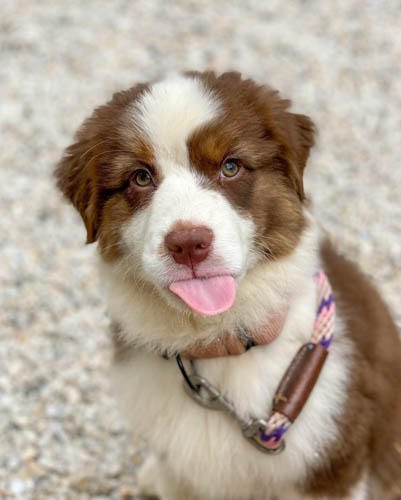There is a lot of information out there about how to teach your dogs to eat. Most owners do not want their dogs to grow overweight, so it is important to teach dogs to eat.
Eating disorders can be serious, but at The Doggy Doggy Spas, we know that not all eating disorders are the same. Each condition has unique symptoms and treatment plans, so be sure to consult your veterinarian before starting any diet or treatment.
Not all dogs like to eat, and dogs that do not like to eat may be suffering from an eating disorder. This article will educate you on the five most common dog eating disorders and what you can do to help your dogs to eat and stay fit.
1. Pica – Dog’s Eating Disorders

One of the most overlooked health conditions in the dog world is pica, in which dogs eat inedible non-food items, including dirt, rocks, wood, plastic, paper, metal, glass, rubber, etc. Most people don’t even think of their pets as having eating disorders.
Most people don’t even know that pica exists in dogs. Pica is a disorder that affects both dogs and humans and is characterized by an abnormal appetite for non-food items that can lead to serious physical and mental health issues.
Pica can be a symptom of a larger condition, and its impact can be fatal and life-threatening. Dog owners who have never experienced a dog with a Pica can find it difficult to know what to do. If a dog is showing signs of a Pica, there are a number of things that can be done.
Pica is the term used to describe the compulsive eating of non-edible objects. It can be triggered by any number of factors, including an inconvenience with the owner’s diet.
It is most common in animals, though humans can exhibit pica in different forms. Some examples in dogs include corn chips, Cheetos, salt, sugar, and ground pepper.
It is important to check your dog for potentially serious medical conditions. Many common conditions can affect dogs, but it can be difficult to find the signs of these conditions early on.
When it is love, the dog’s overall health is more important than signs of an eating disorder. These eating disorders can cause weight loss, lack of eating, vomiting, lethargy, and diarrhea.
2. Scoffing

The newest eating disorder sweeping the nation is one that’s fairly new to the dog world as well: scoffing or bolting food. In this eating disorder, a dog eats a meal fairly quickly, often without much chewing, and then vomits within a short period. This leads to gastrointestinal or choking problems such as gastric torsion, vomiting, or bloat.
Have you ever noticed how often your dog is eating out of the garbage or wherever is their favorite food source? Often, that means they are hungry. When your dog is hungry, it can become aggressive or “moody.”
Sometimes they may react to the situation through barking, sometimes through inappropriate urination. Even dogs that become aggressive because of their diet, like dogs that eat too much table food. One of the first things we as dog owners should teach our dogs is how to eat properly.
This is not as simple as it sounds, as many breeds of dogs have trouble with the desire to bite their food and will anxiously paw at it, or worse, risk choking on it.
However, if we can teach them how to eat and keep them from accessing their food until we’re ready to eat, we can prevent the onset of many behavior problems, which could lead to health problems and even death.
3. Overeating

Over-eating is a common culprit in the weight gain of canines. Although no one diet will work for every dog, certain behaviors can lead to weight gain. Many dog owners make the mistake of thinking obesity results from their dog overeating because they can’t control their pooch.
Unfortunately, this is not the case. Obesity is a problem that can affect both cats and dogs, and it can be a very serious health issue. Eating disorders in dogs are not uncommon, and they can be a sign that there is a problem with your dog’s overall health.
It’s important to pay attention to your dog’s weight and take note if their behavior starts to change. If you notice any of the following signs, you should seek professional help.
Feeding your dog is one of the most important things you can do for your furry friend, but it’s also one of the most frustrating. Many pet parents assume that a dog begging means that they’re hungry, but most dogs are opportunistic eaters. They will eat what they can whenever they can get it, whether they’re full or not.
Obesity is a serious concern in the United States today. While we can’t claim we can tell you what caused your dog to gain weight, we can tell you the most common causes of obesity in dogs. Many overweight or obese dogs make it to a reputable veterinarian for a physical exam and blood work.
These tests can show the cause of obesity and correct the problem. If it is a hormonal disease, such as Cushing’s disease, the dog will need to be treated with medications to stop the growth of the tumors.
Why do dogs eat too much? It’s easy for them to overeat. You want to meet your dog’s needs, so you feed them more than your dog needs. You want them to be happy and healthy, so you feed them more than they need. But if your dog eats too much, its metabolism slows down.
Their body runs without energy, so they feel tired and sleepy. Obesity, diabetes, and other diseases can develop, and their teeth and bones can get damaged.
4. Under-Eating Or Anorexia

Some days it seems like the only reason dogs get food is to get food. You can’t hold a dog or take it for walks, but if the dog is hungry, it’s time to feed it. But what happens when the dog stops eating? Dogs get hungry too, but certain signs indicate that your dog isn’t getting the nutrition it needs to stay healthy.
A dog owner with a family may not know what to do when their dog suddenly develops an eating disorder. There is no typical dog anorexia; each dog develops their unique pattern of behavior.
Over the years, anorexia (without the “a”) has always been seen as a disorder of the human body. However, it is not uncommon to see the signs of anorexia in pet dogs as well. The signs can be very similar to those seen in humans suffering from the disorder.
The signs include lethargy, jaundice, abdominal distension, loss of appetite, vomiting, diarrhea, fever, abdominal distension, changes in organ size, pain, jaundice, weakness, decreased appetite, pneumonia, shortness of breath, changes in organ size, abdominal distension, etc.
This article will tell you if you want to know what happens in your dog’s body when he starts to lose weight. After all, if you choose to feed your dog, you should know how it affects him.
There are many causes for under-eating in dogs. Some common causes of under-eating in dogs are gastrointestinal problems, such as a blockage in the digestive tract, a parasite, a bacterial infection, a parasitic infection, a foreign body, a change in the dog’s instinctive behavior, or a change in the dog’s environment. Another cause of under-eating in dogs is the illness of the dog’s owner.
We all know that dogs are man’s best friend. But if you have not noticed, following closely behind are all the things to keep your dogs happy, well entertained, and healthy! To ensure that your dog is happy, healthy, well-groomed, and ready for the summer months, you must be up-to-date with your regular grooming routine.
This will ensure your dog is happy, healthy, well-groomed, and ready for the summer months. Understanding how your dog thinks and behaves can help you understand why they perform certain behaviors.
One area that you can help your dog by understanding is his diet. Many dogs are very concerned with what is in their food. He may not be able to tell you what it is, but he will certainly know when something is wrong.
5. Feces Eating Or Coprophagia

Coprophagia is the term used to describe how some dogs eat their feces. The behavior is typically exhibited by dogs suffering from anxiety, boredom, stress, or illness. The feces may be eaten immediately or saved until later. Coprophagia can be dangerous, as the dog could be seriously sick, have an eating disorder, or have diarrhea.
There are many types of eating disorders that can develop in both dogs and humans. Whether you’re dealing with anorexia, bulimia, or binge-eating disorder, this article will discuss these disorders in more detail.
We all know that dogs poop and how important it is for dogs to access a clean, poop-free environment. But have you ever considered how it can be used as a tool to help dogs with other issues?
Some dogs have various eating disorders, anorexia. If their digestive systems are not functioning or do not have enough energy to go outside to relieve themselves, they are at risk of potentially dangerous conditions.
If you’ve ever owned a dog, you’re probably familiar with diarrhea. Not only is it unpleasant, but it can also be expensive because it requires your dog to visit the veterinarian.
While there’s no reason to believe this common problem is related to your dog’s diet, the occasional bout of loose stools can be discouraging when you’re trying to train them or when you’re preparing for a show.
Several different eating disorders affect dogs. Some of these are common, some are rare. The veterinary community recognizes some; some are not.
Some are easy to spot, some are not. Some are easy to diagnose, some are not. Some are easy to treat, some are not. The truth about your dog’s eating habits can be very hard to accept. But not if you know the truth.
Do not be deceived by what you see on TV or what your dog’s behavior portrays; it is easy to associate behavioral changes with illness. Your best course of action is to do your homework. Be informed and educated about eating disorders. With you knowledgeable about eating disorders, your dog can be the best ally in your fight against eating disorders.
There are many things you can do to help your dog if he or she is suffering from an eating disorder. You can make sure your dog is confined to a safe, comfortable environment. You can observe your dog closely for signs of anxiety or stress and then take action as soon as possible.
You can replace the food your dog is eating with a variety of nutritious, calorie-controlled meals. You can look for a behaviorist who can help you and your dog through this difficult time. There are several types of eating disorders, but there are three components: thoughts, behaviors, and physical effects.
When an eating disorder afflicts people, they are often unaware of the eating disorder’s existence. However, eating disorders are not to be taken lightly, so it is critical to seek professional help if you suspect your dog is suffering from one.
